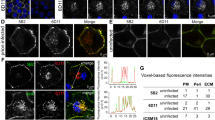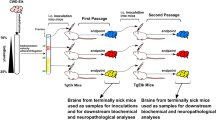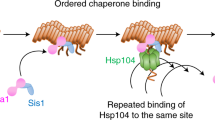Abstract
Sequence-specific nucleated protein aggregation is closely linked to the pathogenesis of most neurodegenerative diseases and constitutes the molecular basis of prion formation1. Here we report that fibrillar polyglutamine peptide aggregates can be internalized by mammalian cells in culture where they gain access to the cytosolic compartment and become co-sequestered in aggresomes together with components of the ubiquitin-proteasome system and cytoplasmic chaperones. Remarkably, these internalized fibrillar aggregates are able to selectively recruit soluble cytoplasmic proteins with which they share homologous but not heterologous amyloidogenic sequences, and to confer a heritable phenotype on cells expressing the homologous amyloidogenic protein from a chromosomal locus.
This is a preview of subscription content, access via your institution
Access options
Subscribe to this journal
Receive 12 print issues and online access
$209.00 per year
only $17.42 per issue
Buy this article
- Purchase on Springer Link
- Instant access to full article PDF
Prices may be subject to local taxes which are calculated during checkout




Similar content being viewed by others
References
Chiti, F. & Dobson, C. M. Protein misfolding, functional amyloid, and human disease. Annu. Rev. Biochem. 75, 333–366 (2006).
Taylor, J. P., Hardy, J. & Fischbeck, K. H. Toxic proteins in neurodegenerative disease. Science 296, 1991–1995 (2002).
Carrell, R. W. & Lomas, D. A. Conformational disease. Lancet 350, 134–138 (1997).
Pepys, M. B. Amyloidosis. Annu. Rev. Med. 57, 223–241 (2006).
Sousa, M. M., Cardoso, I., Fernandes, R., Guimaraes, A. & Saraiva, M. J. Deposition of transthyretin in early stages of familial amyloidotic polyneuropathy: evidence for toxicity of nonfibrillar aggregates. Am. J. Pathol. 159, 1993–2000 (2001).
Ross, C. A. & Poirier, M. A. Protein aggregation and neurodegenerative disease. Nature Med. 10, S10–17 (2004).
Bucciantini, M. et al. Inherent toxicity of aggregates implies a common mechanism for protein misfolding diseases. Nature 416, 507–511 (2002).
Yang, W., Dunlap, J. R., Andrews, R. B. & Wetzel, R. Aggregated polyglutamine peptides delivered to nuclei are toxic to mammalian cells. Hum. Mol. Genet. 11, 2905–2917 (2002).
Morten, I. J., Gosal, W. S., Radford, S. E. & Hewitt, E. W. Investigation into the role of macrophages in the formation and degradation of beta2-microglobulin amyloid fibrils. J. Biol. Chem. 282, 29691–29700 (2007).
Lee, H. J. et al. Assembly-dependent endocytosis and clearance of extracellular α-synuclein. Int. J. Biochem. Cell Biol. 40, 1835–1849 (2008).
Li, J. Y. et al. Lewy bodies in grafted neurons in subjects with Parkinson's disease suggest host-to-graft disease propagation. Nature Med. 14, 501–503 (2008).
Chen, S. & Wetzel, R. Solubilization and disaggregation of polyglutamine peptides. Protein Sci. 10, 887–891 (2001).
Chen, S., Berthelier, V., Hamilton, J. B., O'Nuallain, B. & Wetzel, R. Amyloid-like features of polyglutamine aggregates and their assembly kinetics. Biochemistry 41, 7391–7399 (2002).
Heuser, J. The production of 'cell cortices' for light and electron microscopy. Traffic 1, 545–552 (2000).
Jana, N. R., Tanaka, M., Wang, G. & Nukina, N. Polyglutamine length-dependent interaction of Hsp40 and Hsp70 family chaperones with truncated N-terminal huntingtin: their role in suppression of aggregation and cellular toxicity. Hum. Mol. Genet. 9, 2009–2018 (2000).
Cohen, F. E. Protein misfolding and prion diseases. J. Mol. Biol. 293, 313–320 (1999).
Santoso, A., Chien, P., Osherovich, L. Z. & Weissman, J. S. Molecular basis of a yeast prion species barrier. Cell 100, 277–288 (2000).
Rujano, M. A. et al. Polarised asymmetric inheritance of accumulated protein damage in higher eukaryotes. PLoS Biol. 4, e417 (2006).
Kayed, R. et al. Permeabilization of lipid bilayers is a common conformation-dependent activity of soluble amyloid oligomers in protein misfolding diseases. J. Biol. Chem. 279, 46363–46366 (2004).
Porat, Y., Kolusheva, S., Jelinek, R. & Gazit, E. The human islet amyloid polypeptide forms transient membrane-active prefibrillar assemblies. Biochemistry 42, 10971–10977 (2003).
Khémtemourian, L., Killian, J. A., Hoppener, J. W. & Engel, M. F. Recent insights in islet amyloid polypeptide-induced membrane disruption and its role in β-cell death in type 2 diabetes mellitus. Exp. Diabetes Res. 2008, 421287 (2008).
Chen, S., Berthelier, V., Yang, W. & Wetzel, R. Polyglutamine aggregation behavior in vitro supports a recruitment mechanism of cytotoxicity. J. Mol. Biol. 311, 173–182 (2001).
DePace, A. H., Santoso, A., Hillner, P. & Weissman, J. S. A critical role for amino-terminal glutamine/asparagine repeats in the formation and propagation of a yeast prion. Cell 93, 1241–1252 (1998).
Scherzinger, E. et al. Self-assembly of polyglutamine-containing huntingtin fragments into amyloid-like fibrils: implications for Huntington's disease pathology. Proc. Natl Acad. Sci. USA 96, 4604–4609 (1999).
Heuser, J. Three-dimensional visualization of coated vesicle formation in fibroblasts. J. Cell Biol. 84, 560–583 (1980).
Wanker, E. E. et al. Membrane filter assay for detection of amyloid-like polyglutamine- containing protein aggregates. Methods Enzymol. 309, 375–386 (1999).
Scherzinger, E. et al. Huntingtin-encoded polyglutamine expansions form amyloid-like protein aggregates in vitro and in vivo. Cell 90, 549–558 (1997).
Acknowledgements
We thank J. Perrino and J. Mulholland for help with electron and confocal microscopy; K. Kirkegaard for comments on the manuscript and G. Chang and T. Hastie for statistical analysis. This research was supported in part by a grant from the NINDS and a Stanford Graduate Fellowship to P.-H.R.; R.M. is supported by the CNRS and the ANR contract no. ANR-06-BLAN-0266.
Author information
Authors and Affiliations
Contributions
P.-H.R. contributed principally to the conception and design of the study, acquisition, analysis and interpretation of the data; J.E.L. and R.M. acquired, analysed and interpreted data and provided critical comments; I.K. contributed the experiment in Fig. 3d; J.E.H. contributed to the electron microscopic analysis and contributed substantially to the interpretation of the data; R.R.K. conceived and designed the study, and wrote and revised the manuscript.
Corresponding author
Ethics declarations
Competing interests
The authors declare no competing financial interests.
Supplementary information
Supplementary Information
Supplementary Information (PDF 725 kb)
Rights and permissions
About this article
Cite this article
Ren, PH., Lauckner, J., Kachirskaia, I. et al. Cytoplasmic penetration and persistent infection of mammalian cells by polyglutamine aggregates. Nat Cell Biol 11, 219–225 (2009). https://doi.org/10.1038/ncb1830
Received:
Accepted:
Published:
Issue Date:
DOI: https://doi.org/10.1038/ncb1830
This article is cited by
-
Research progress on the role of extracellular vesicles in neurodegenerative diseases
Translational Neurodegeneration (2023)
-
Statins suppress cell-to-cell propagation of α-synuclein by lowering cholesterol
Cell Death & Disease (2023)
-
Vaccines for prion diseases: a realistic goal?
Cell and Tissue Research (2023)
-
Effects of oligomer toxicity, fibril toxicity and fibril spreading in synucleinopathies
Cellular and Molecular Life Sciences (2022)
-
Fast kinetics of environmentally induced α-synuclein aggregation mediated by structural alteration in NAC region and result in structure dependent cytotoxicity
Scientific Reports (2020)



